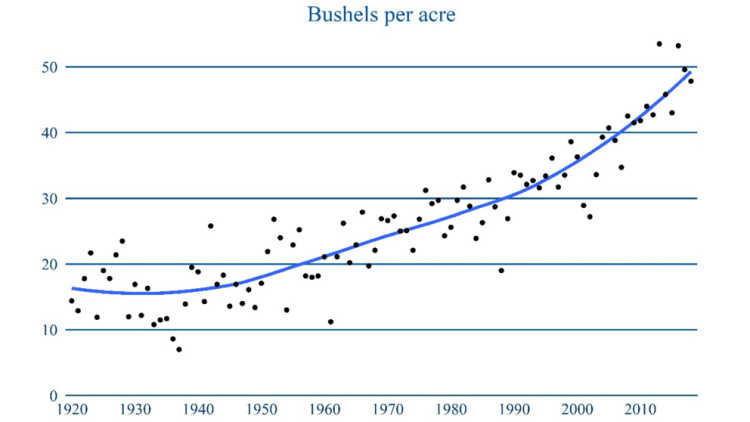How productivity gains affect farm income – part 1

Planting is in full swing. If the weather cooperates, we expect record or near record yields for Canadian crops because yields trend upward. Agriculture has long experienced productivity gains. Innovations such as GMOs and precision agriculture are transforming today’s agriculture. CRISPR gene editing technologies are expected to soon make positive contributions.
Productivity gains are desirable to society, but their economic impacts aren’t shared by all. This week and next, we’ll explore how productivity gains affect farm income and how farmers can stay ahead.
Productivity gains in Canada agriculture
Figure 1 shows the remarkable increase in yields for wheat in Canada. Yields vary from year to year because of weather, but generally trend up. Wheat yields in the 1920s were about 15 bushels per acre. Today, they’re about 50 bushels per acre, making land more than three times more productive than it was 100 years ago.
Notice how yields have started increasing at a faster pace during the Green Revolution in the 1950s and 1960s. Although quiet and often forgotten, it was one of the most transformative events of the 20th century.
During the 1950s and 1960s, the farm sector saw the introduction of synthetic fertilizers, hybrid crops and pesticides. The development and the adoption of these technologies helped feed a rapidly growing population and caused the number of farms to decline as they grew to adopt productivity enhancing technologies.
Figure 1: Wheat yields in Canada trend up

Data from Statistics Canada
The wheat example is not unique. Productivity gains have continued since the Green Revolution. I’ve documented on my X feed other examples of productivity gains in Canada agriculture:
Yields for major crops in Canada
Productivity in milk production
Gains in productivity in hog production
Yield per tap in maple syrup production
Butterfat yield in milk
Expected yields and farm income
Statistics Canada recently released Canadian planting intentions for 2019. Farmers’ planting decisions are based on the expected revenues per acre (expected yield times expected price). Let’s see how productivity gains affect a farmer’s expected revenue per acre.
Productivity gains affect a farmer’s expected revenue per acre but not always positively.
As yields trend up, farmers expect increasing output under normal growing conditions and thus higher revenues.
At planting time crop prices will be a function of anticipated supply and thus projected yields.
The effect of increased yield on income isn’t obvious. On one side, productivity gains increase revenues per acre by augmenting output. On the other side, as yields trend up for all farmers, they increase total supply and put downward pressure on prices.
Whether crop revenues per acre increase depends on yields increasing at a greater pace than the price tends to decline, and whether demand increases.
What's coming?
Next week, we’ll examine how productivity gains at the farm affect consumers and farmers. We ask how farmers can stay ahead if farm income stalls because of productivity gains.
Article by: Sébastien Pouliot, Principal Economist